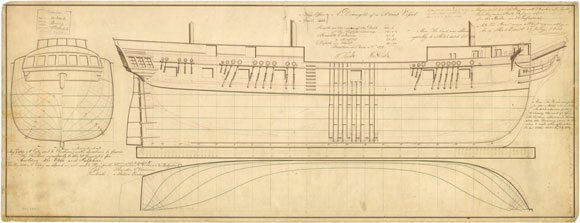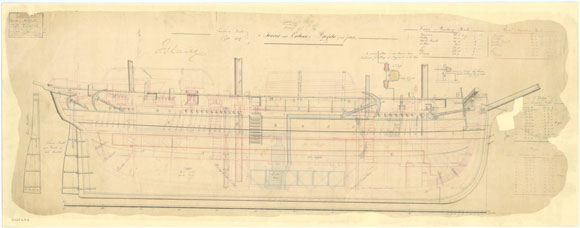Parks Canada 2010 Arctic Surveys
The Vessels
HMS Erebus
HMS Erebus was a bomb vessel of the Hecla class, a slightly larger version of HMSTerror’s Vesuvius class. These ship-rigged vessels (three-masts with square sails) were built solidly to carry two mortars with a complement of 10 canon including eight 24-pounder guns. Their robust construction made them good candidates for polar exploration. The 372-ton Erebus was 105 feet (32 m) long and 28.5 feet (8.7 m) wide. Built in the Pembroke dockyards in Wales, she was launched on June 7, 1826. After serving in the Mediterranean, she was modified for polar exploration and took part in James Clark Ross’ four-year expedition to the Antarctic, from 1836 to 1843, along with HMS Terror. Like Terror, Erebus was equipped with 20-horse-power steam engines and a screw propeller for auxiliary propulsion before taking part in Sir John Franklin’s expedition.
 HMS Erebus. Profile plan of 'Erebus' (1826)
HMS Erebus. Profile plan of 'Erebus' (1826)© National Maritime Museum, Greenwich, London
Sources:
David Lyon, The Sailing Navy List. All the Ships of the Royal Navy – Built, Purchased and Captured – 1688-1860, Conway Maritime Press, London, 1993.
Lincoln P. Paine, Ships of the World. An Historical Encyclopedia, Houghton Mifflin Company, Boston and New-York, 1997.
David Lyon, The Sailing Navy List. All the Ships of the Royal Navy – Built, Purchased and Captured – 1688-1860, Conway Maritime Press, London, 1993.
Lincoln P. Paine, Ships of the World. An Historical Encyclopedia, Houghton Mifflin Company, Boston and New-York, 1997.
HMS Terror
HMS Terror was a bomb vessel of the Vesuvius class. These ship-rigged vessels (three-masts with square sails) were built solidly to carry two mortars with a complement of 10 canon including eight 24-pounder guns. Their robust construction made them good candidates for polar exploration. A little over 325 tons, Terror was 102 feet (31.1 m) long and 27 feet (8.2 m) wide. Built in the Davy shipyard in Topsham, she was launched on June 29, 1813. Erebus took part in the War of 1812, and after some service in the Mediterranean, she started her service as an exploration ship in 1836 when she took part in her first Arctic trip under the command of George Back. Having barely made it back to Ireland, she was repaired and in 1839 left England with HMS Erebus as part of James Clark Ross’ expedition to Antarctica. During the four year voyage, she was under the command of Francis Crozier. Before departure with Sir John Franklin’s expedition in 1845, she was equipped with 20-horse-power steam engines and a screw propeller for auxiliary propulsion. In her last voyage, she was still under the command of Captain Crozier.
 HMS Terror. Profile plan of 'Terror' (1813)
HMS Terror. Profile plan of 'Terror' (1813)© National Maritime Museum, Greenwich, London
Sources:
David Lyon, The Sailing Navy List. All the Ships of the Royal Navy – Built, Purchased and Captured – 1688-1860, Conway Maritime Press, London, 1993.
Lincoln P. Paine, Ships of the World. An Historical Encyclopedia, Houghton Mifflin Company, Boston and New-York, 1997.
David Lyon, The Sailing Navy List. All the Ships of the Royal Navy – Built, Purchased and Captured – 1688-1860, Conway Maritime Press, London, 1993.
Lincoln P. Paine, Ships of the World. An Historical Encyclopedia, Houghton Mifflin Company, Boston and New-York, 1997.

No comments:
Post a Comment